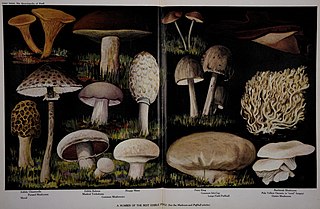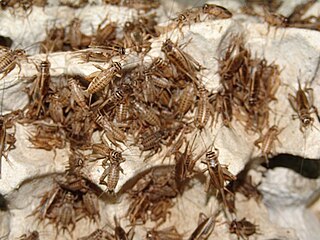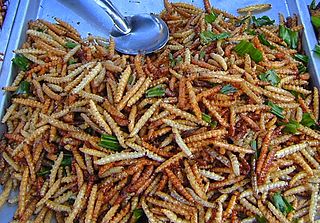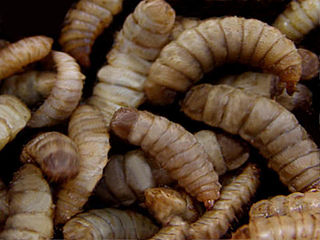Related Research Articles

Eragrostis tef, also known as teff, Williams lovegrass or annual bunch grass, is an annual grass, a species of lovegrass native to the Horn of Africa, notably to both Eritrea and Ethiopia. It is cultivated for its edible seeds, also known as teff. Teff was one of the earliest plants domesticated. It is one of the most important staple crops in Ethiopia and Eritrea.

Locusts are various species of short-horned grasshoppers in the family Acrididae that have a swarming phase. These insects are usually solitary, but under certain circumstances they become more abundant and change their behaviour and habits, becoming gregarious. No taxonomic distinction is made between locust and grasshopper species; the basis for the definition is whether a species forms swarms under intermittently suitable conditions; this has evolved independently in multiple lineages, comprising at least 18 genera in 5 different acridid subfamilies.

The desert locust is a species of locust, a periodically swarming, short-horned grasshopper in the family Acrididae. They are found primarily in the deserts and dry areas of northern and eastern Africa, Arabia, and southwest Asia. During population surge years, they may extend north into parts of western Spain and southern Italy, south into Eastern Africa, and east in northern India. The desert locust shows periodic changes in its body form and can change in response to environmental conditions, over several generations, from a solitary, shorter-winged, highly fecund, non-migratory form to a gregarious, long-winged, and migratory phase in which they may travel long distances into new areas. In some years, they may thus form locust plagues, invading new areas, where they may consume all vegetation including crops, and at other times, they may live unnoticed in small numbers.

Wageningen University & Research is a public university in Wageningen, Netherlands, specializing in life sciences with a focus on agriculture, technical and engineering subjects. It is a globally important center for life sciences and agricultural research. It is located in a region of the Netherlands known as the Food Valley.

Entomophagy in humans or human entomophagy describes the consumption of insects (entomophagy) by humans in a cultural and biological context. The scientific term used in anthropology, cultural studies, biology and medicine is anthropo-entomophagy. Anthropo-entomophagy does not include the eating of arthropods other than insects such as arachnids and myriapods, which is defined as arachnophagy.

An edible item is any item that is safe for humans to eat. "Edible" is differentiated from "eatable" because it does not indicate how an item tastes, only whether it is fit to be eaten. Nonpoisonous items found in nature – such as some mushrooms, insects, seaweed, and so forth – are referred to as edible. Processed items that normally are not ingested but are specially manufactured to be so, like edible underwear or edible packaging, are also labeled as edible.
In animal husbandry, feed conversion ratio (FCR) or feed conversion rate is a ratio or rate measuring of the efficiency with which the bodies of livestock convert animal feed into the desired output. For dairy cows, for example, the output is milk, whereas in animals raised for meat the output is the flesh, that is, the body mass gained by the animal, represented either in the final mass of the animal or the mass of the dressed output. FCR is the mass of the input divided by the output. In some sectors, feed efficiency, which is the output divided by the input, is used. These concepts are also closely related to efficiency of conversion of ingested foods (ECI).

A sustainable food system is a type of food system that provides healthy food to people and creates sustainable environmental, economic and social systems that surround food. Sustainable food systems start with the development of sustainable agricultural practices, development of more sustainable food distribution systems, creation of sustainable diets and reduction of food waste throughout the system. Sustainable food systems have been argued to be central to many or all 17 Sustainable Development Goals.

Animal feed is food given to domestic animals, especially livestock, in the course of animal husbandry. There are two basic types: fodder and forage. Used alone, the word feed more often refers to fodder. Animal feed is an important input to animal agriculture, and is frequently the main cost of the raising or keeping of animals. Farms typically try to reduce cost for this food, by growing their own, grazing animals, or supplementing expensive feeds with substitutes, such as food waste like spent grain from beer brewing.
Sustainable consumption is the use of products and services in ways that minimize impacts on the environment in order for human needs to be met in the present but also for future generations. Sustainable consumption is often paralleled with sustainable production; consumption refers to use and disposal not just by individuals and households, but also by governments, businesses, and other organizations. Sustainable consumption is closely related to sustainable production and sustainable lifestyles. "A sustainable lifestyle minimizes ecological impacts while enabling a flourishing life for individuals, households, communities, and beyond. It is the product of individual and collective decisions about aspirations and about satisfying needs and adopting practices, which are in turn conditioned, facilitated, and constrained by societal norms, political institutions, public policies, infrastructures, markets, and culture."

Insect farming is the practice of raising and breeding insects as livestock, also referred to as minilivestock or micro stock. Insects may be farmed for the commodities they produce, or for them themselves; to be used as food, as feed, as a dye, and otherwise.

Insects as food or edible insects are insect species used for human consumption. More than 2,000 insects species worldwide are considered edible. However, a much smaller number is discussed for industrialized mass production and partly regionally authorized for use in food. Common forms of consumption are whole insects on the one hand, and pulverized insects that are used as an ingredient in dishes or in processed food products such as burger patties, pasta, or snacks, on the other hand.
Global Steak: Demain nos enfants mangeront des criquets is a 2010 French documentary television film directed by Anthony Orliange.
Gert Spaargaren is a Dutch professor at the Wageningen University, author, and editor. Spaargaren is from Aalsmeer, Netherlands, and is currently teaching Environmental Policy for sustainability and patterns of consumption in the Department of Social Sciences. His fields of expertise are Consumer Studies and Environmental policy.

The welfare of farmed insects concerns treatment of insects raised for animal feed, as food or pet food, and other purposes such as honey and silk.
Insect-based pet food is pet food consisting of, or containing insects digestible by pets such as dogs or cats. A limited, but growing number of products are available on the market, including insect-based cat food, dog food, and pet treats.

Various cultures throughout Africa utilize insects for many things and have developed unique interactions with insects: as food sources, for sale or trade in markets, or for use in traditional practices and rituals, as ethnomedicine or as part of their traditional ecological knowledge. As food, also known as entomophagy, a variety of insects are collected as part of a protein rich source of nutrition for marginal communities. Entomophagy had been part of traditional culture throughout Africa, though this activity has been diminishing gradually with the influx of Western culture and market economies. Often the collection of insects for food has been the activity of children, both male and female.

InnovaFeed SAS, a French biotechnology company founded in 2016, develops insect-breeding and -processing processes. It sells ingredients derived from insects for animal nutrition and in particular aquaculture.

Insects as feed are insect species used as animal feed, either for livestock, including aquaculture, or as pet food.

Marcel Dicke is a Dutch professor of entomology who has been affiliated with Wageningen University since 2002. He conducts research on insects and has published in the scientific journals Science and Nature. Dicke received the Spinoza Prize in 2007 for his research on the interactions between plants and insects.
References
- ↑ Wageningen University: Prof. Dr. ir. Arnold van Huis .
- ↑ "Dutch scientist advocates bugs as a green superfood". BBC News. 2011-01-18. Archived from the original on 1 August 2022. Retrieved 2022-08-01.
- ↑ Carrington, Damian (2010-07-31). "Insects could be the key to meeting food needs of growing global population". the Guardian. Archived from the original on 8 April 2022. Retrieved 2022-08-01.
- ↑ "Laboratorium voor Entomologie". WUR (in Dutch). 2012-12-04. Archived from the original on 14 March 2022. Retrieved 2022-08-01.